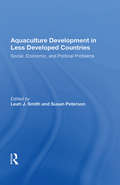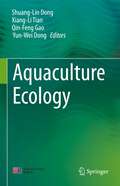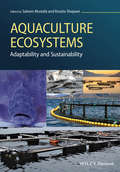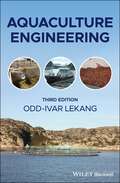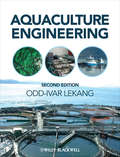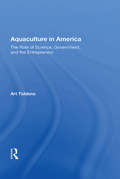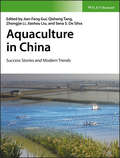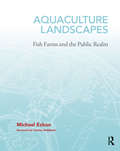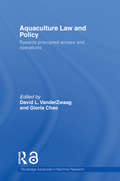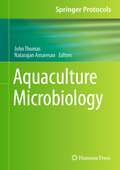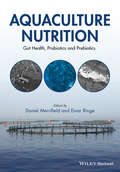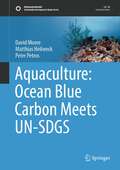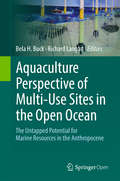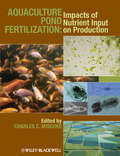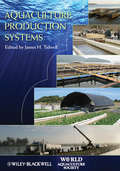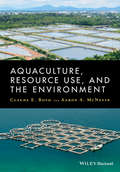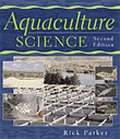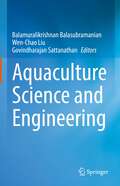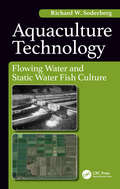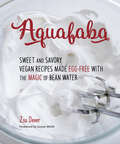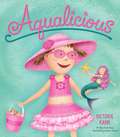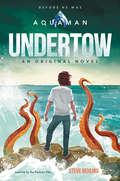- Table View
- List View
Aquaculture Development In Less Developed Countries: Social, Economic, And Political Problems
by Leah SmithAquaculture may not be the panacea for the world's food problems, but It has the potential to make important contributions to diet and incomes in some areas. This book, intended to improve planning for further development of aquaculture, examines the factors that can determine the success or failure of aquaculture projects in developing countries.
Aquaculture Ecology
by Shuang-Lin Dong Xiang-Li Tian Qin-Feng Gao Yun-Wei DongThis book introduces aquaculture ecology as a science of the interaction between commercial aquatic organisms as well as their farming activities and the environment, including the rationales of building and management of aquaculture systems. This book covers productivity and carrying capacity, effects of cyclical fluctuation of environmental factors on aquatic organisms, biological control of water quality, structural optimization of aquaculture systems and ecological prevention of disease. In the last chapter, aquaculture production systems are introduced from multiple perspectives.This book has been designed to provide a stimulating and informative text for researchers in aquaculture, fisheries as well as hydrobiology.
Aquaculture Economics and Financing: Management and Analysis
by Carole R. EngleAquaculture Economics and Financing: Management and Analysis provides a detailed and specific set of guidelines for using economic and financial analysis in aquaculture production. By discussing key issues such as how to finance and plan new aquaculture business, how to monitor and evaluate economic performance, and how to manage capital, labor, and business risk, the book equips aquaculture professionals, researchers, and students with important information applicable to a wide range of business decisions. Chapters address each stage of developing an aquaculture business, including financing, marketing, and developing a business plan to managing cash flows and analyzing financial statements. Each chapter includes a detailed example of practical application taken from every-day experience. Written in straightforward terminology facilitating ready application, Aquaculture Economics and Financing: Management and Analysis is an essential tool for analyzing and improving financial performance of aquaculture operations.
Aquaculture Ecosystems
by Saleem Mustafa Rossita ShapawiAquaculture Ecosystems contains a thorough and exciting synthesis of current information on aquaculture practices and substantial discussion of the way forward in transforming the aquaculture industry by improving its sustainability. This important book includes discussion of all the current major issues relating to aquaculture practices in relation to the ecology of their situations, environmental concerns, and details of how sustainability can be improved. Efforts have been made to include chapters that go beyond the stage of debate on old topics, providing conclusions to provide leads for action plans and practices addressing modern challenges such as global climate change. Commencing with a chapter covering concerns and solutions centred around seafood security, the following chapters cover the biology and behavior of aquatic animals and their selection for use in aquaculture systems, integrated multi-trophic aquaculture, nutrient inputs and pollution, biofouling, blue carbon stocks in coastal aquaculture, climate change adaptations and knowledge management in aquaculture. Written by internationally-recognized experts in aquaculture and ecology, and edited by Saleem Mustafa, well known for his work in aquatic sciences, the book provides a great deal of use and interest to all those involved in aquaculture planning and development, environmental sciences and aquatic ecology. All libraries in universities and research establishments where biological sciences and aquaculture are studied and taught should have copies of this vital reference on their shelves.
Aquaculture Engineering
by Odd-Ivar LekangThe revised edition of the comprehensive book that explores the principles and applications of aquaculture engineering Since the publication of the first edition of Aquaculture Engineering there have been many advances in the industry. The revised and thoroughly updated third edition of Aquaculture Engineering covers the principles and applications of all major facets of aquaculture engineering and the newest developments in the field. Written by a noted expert on the topic, the new edition highlights information on new areas of interest including RAS technology and offshore fish farming. Comprehensive in scope, the book examines a range of topics including: water transportation and treatment; feed and feeding systems; fish transportation and grading; cleaning and waste handling; instrumentation and monitoring; removal of particles; aeration and oxygenation; recirculation and water reuse systems; ponds; and the design and construction of aquaculture facilities. This important book: Presents an updated review of the basic principles and applications in aquaculture engineering Includes information on new areas of focus; RAS technology and offshore fish farming Contains a revised edition of the classic resource on aquaculture engineering Continues to offer an authoritative guide written by a leading expert in the field Written for aquaculture scientists and managers, engineers, equipment manufacturers and suppliers, and biological scientists, the third edition of Aquaculture Engineering is the authoritative guide to the topic that has been updated to include the most recent developments in the industry.
Aquaculture Engineering
by Odd-Ivar LekangAs aquaculture continues to grow at a rapid pace, understanding the engineering behind aquatic production facilities is of increasing importance for all those working in the industry. Aquaculture engineering requires knowledge of the many general aspects of engineering such as material technology, building design and construction, mechanical engineering, and environmental engineering. In this comprehensive book now in its second edition, author Odd-Ivar Lekang introduces these principles and demonstrates how such technical knowledge can be applied to aquaculture systems. Review of the first edition: 'Fish farmers and other personnel involved in the aquaculture industry, suppliers to the fish farming business and designers and manufacturers will find this book an invaluable resource. The book will be an important addition to the shelves of all libraries in universities and research institutions where aquaculture, agriculture and environmental sciences are studied and taught.' Aquaculture Europe 'A useful book that, hopefully, will inspire successors that focus more on warm water aquaculture and on large-scale mariculture such as tuna farming.' Cision
Aquaculture In America: The Role Of Science, Government, And The Entrepreneur
by Art TiddensTiddens' job is to track (one might suspect, to advance) the financial prospects for American companies cultivating aquatic plants and animals. He surveys the support currently available from state and federal governments and scientific institutions and urges that more is needed.
Aquaculture in China: Success Stories and Modern Trends
by Jian-Fang Gui Qisheng Tang Zhongjie Li Jiashou Liu Sena S. De SilvaFish have been a major component of our diet and it has been suggested that fish/seafood consumption contributed to the development of the human brain, and this together with the acquisition of bipedalism, perhaps made us what we are. In the modern context global fish consumption is increasing. However, unlike our other staples, until a few years back the greater proportion of our fish supplies were of a hunted origin. This scenario is changing and a greater proportion of fish we consume now is of farmed origin. Aquaculture, the farming of waters, is thought to have originated in China, many millennia ago. Nevertheless, it transformed into a major food sector only since the second half of the last century, and continues to forge ahead, primarily in the developing world. China leads the global aquaculture production in volume, in the number of species that are farmed, and have contributed immensely to transforming the practices from an art to a science. This book attempts to capture some of the key elements and practices that have contributed to the success of Chinese aquaculture. The book entails contributions from over 100 leading experts in China, and provides insights into some aquaculture practices that are little known to the rest of the world. This book will be essential reading for aquaculturists, practitioners, researchers and students, and planners and developers.
Aquaculture Landscapes: Fish Farms and the Public Realm
by Michael EzbanAquaculture Landscapes explores the landscape architecture of farms, reefs, parks, and cities that are designed to entwine the lives of fish and humans. In the twenty-first century, aquaculture’s contribution to the supply of fish for human consumption exceeds that of wild-caught fish for the first time in history. Aquaculture has emerged as the fastest growing food production sector in the world, but aquaculture has agency beyond simply converting fish to food. Aquaculture Landscapes recovers aquaculture as a practice with a deep history of constructing extraordinary landscapes. These landscapes are characterized and enriched by multispecies interdependency, performative ecologies, collaborative practices, and aesthetic experiences between humans and fish. Aquaculture Landscapes presents over thirty contemporary and historical landscapes, spanning six continents, with incisive diagrams and vivid photographs. Within this expansive scope is a focus on urban aquaculture projects by leading designers—including Turenscape, James Corner Field Operations, and SCAPE—that employ mutually beneficial strategies for fish and humans to address urban coastal resiliency, wastewater management, and other contemporary urban challenges. Michael Ezban delivers a compelling account of the coalitions of fish and humans that shape the form, function, and identity of cities, and he offers a forward-thinking theorization of landscape as the preeminent medium for the design of ichthyological urbanism in the Anthropocene. With over two hundred evocative images, including ninety original drawings by the author, Aquaculture Landscapes is a richly illustrated portrayal of aquaculture seen through the disciplinary lens of landscape architecture. As the first book devoted to this topic, Aquaculture Landscapes is an original and essential resource for landscape architects, urbanists, animal geographers, aquaculturists, and all who seek and value multispecies cohabitation of a shared public realm.
Aquaculture Law and Policy: Towards principled access and operations (Routledge Advances in Maritime Research)
by David L. VanderZwaag Gloria ChaoThe aquaculture industry is fast expanding around the globe and causing major environmental and social disruptions. The volume is about getting a 'good governance' grip on this important industry. The book highlights the numerous law and policy issues that must be addressed in the search for effective regulation of aquaculture. Those issues include among others: the equitable and fair assignment of property rights; the design of effective dispute resolution mechanisms; clarification of what maritime laws apply to aquaculture; adoption of a proper taxation system for aquaculture; resolution of aboriginal offshore title and rights claims; recognition of international trade law restrictions such as labeling limitations and food safety requirements; and determination of whether genetically modified fish should be allowed and if so under what controls. This book will appeal to a broad range of audiences: undergraduate and postgraduate students, academic researchers, policy makers, NGOs, practicing lawyers and industry representatives.
Aquaculture Microbiology (Springer Protocols Handbooks)
by John Thomas Natarajan AmaresanThis volume details techniques involved to study aquatic pathogens that cause infections, especially in fish. Chapters guide readers through a wide range of basic and advanced methods, viral and fungal pathogens, probiotic bacteria, treatment of pathogens using seaweed extract, medicinal plant extracts, and actinomycetes. Authoritative and cutting-edge, Aquaculture Microbiology aims to be a useful practical guide to researches to help further their study in this field.
Aquaculture Nutrition: Gut Health, Probiotics and Prebiotics
by Daniel L. Merrifield Einar RingoManipulation of the microbial gut content of farmed fishes and crustaceans can have a marked effect on their general health, growth, and quality. Expertly covering the science behind the use of prebiotics and probiotics this landmark book explains how the correct manipulation of the gut flora of farmed fishes and crustaceans can have a positive effect on their health, growth rates, feed utilization, and general wellbeing. Aquaculture Nutrition: Gut Health, Probiotics and Prebiotics provides a comprehensive overview of the current knowledge of the gut microbiomes of fish and their importance with respect to host-fish health and performance, providing in-depth, cutting-edge fundamental and applied information. Written by many of the world’s leading authorities and edited by Dr Daniel Merrifield and Professor Einar Ringø, this important book discusses in detail the common mechanisms for modulating microbiomes, particularly at the gut level (e.g. probiotics, prebiotics and synbiotics). The book is a key resource for an understanding of the historical development of these products, their known mechanisms of action and their degree of efficacy as presently demonstrated in the literature. The fundamental material provided on the gut microbiota itself, and more broad aspects of microbe-live feed interactions, provide essential reading for researchers, academics and students in the areas of aquaculture nutrition, fish veterinary science, microbiology, aquaculture, fish biology and fisheries. Those involved in the development and formulation of aquaculture feeds and those with broader roles within the aquaculture industry will find a huge wealth of commercially-important information within the book’s covers. All libraries in universities and research establishments where biological sciences, nutrition and aquaculture are studied and taught, should have copies of this excellent book on their shelves.
Aquaculture: Ocean Blue Carbon Meets UN-SDGS (Sustainable Development Goals Series)
by David Moore Peter Petros Matthias HeilweckThis book presents a solutions based approach to reducing and removing CO2 from the atmosphere transforming it into solid (crystalline) CaCO3 through the ability of marine organisms such as molluscs, crustacea, corals, and coccolithophore algae. The overwhelming advantage of this approach is that it promises enhanced climate mitigation in comparison to planting forests, industrial/engineering carbon capture and storage process. It also provides a sustainable food resource. Furthermore, it would improve the ocean's biodiversity at the same time as the excess atmospheric CO2 released by our use of fossil fuels is returned to the place it belongs - as a present day fossil, safely out of the atmosphere to the distant future. If the level of finance and global effort that are readily foreseen for forest management and flue gas treatments were applied to expansion of global shellfish cultivation, curative amounts of carbon dioxide could be permanently removed from the atmosphere within a few decades. The concept presented in this book could have a profound influence on the life of the planet.
Aquaculture Perspective of Multi-Use Sites in the Open Ocean: The Untapped Potential for Marine Resources in the Anthropocene
by Bela H. Buck Richard LanganThis book is open access under a CC BY 4. 0 license. This volume addresses the potential for combining large-scale marine aquaculture of macroalgae, molluscs, crustaceans, and finfish, with offshore structures, primarily those associated with energy production, such as wind turbines and oil-drilling platforms. The volume offers a comprehensive overview and includes chapters on policy, science, engineering, and economic aspects to make this concept a reality. The compilation of chapters authored by internationally recognized researchers across the globe addresses the theoretical and practical aspects of multi-use, and presents case studies of research, development, and demonstration-scale installations in the US and EU.
Aquaculture Pond Fertilization: Impacts of Nutrient Input on Production
by Charles C. MischkePonds are a primary production system to a wide variety of freshwater fish species. Each species have specific and unique nutrient needs and successful pond fertilization is critical to a successful aquaculture enterprise. Aquaculture Pond Fertilization: Impacts of Nutrient Input on Production provides state-of-the-art information for successful fertilization strategies for a broad range of pond-raised species. Aquaculture Pond Fertilization attempts to rectify the seemingly contradictory nutrient recommendations by clearly defining the goals of specific types of aquaculture. Chapters are divided into three sections: The first reviews basic concepts in fertilization applicable to all pond-based production. The second looks at specific nutrient management approaches. The third and final section of chapters looks specifically at key freshwater pond species ranging from tilapia to perch and discusses specific fertilization needs for the successful rearing of these in-demand fish. Looking across species with chapters contributed by leaders in the field Aquaculture Pond Fertilization provides succinct single-volume coverage of an oft-neglected, but vitally important topic in aquaculture production.
Aquaculture Production Systems (World Aquaculture Society Book series)
by James H. TidwellAquaculture is an increasingly diverse industry with an ever-growing number of species cultured and production systems available to professionals. A basic understanding of production systems is vital to the successful practice of aquaculture. Published with the World Aquaculture Society, Aquaculture Production Systems captures the huge diversity of production systems used in the production of shellfish and finfish in one concise volume that allows the reader to better understand how aquaculture depends upon and interacts with its environment. The systems examined range from low input methods to super-intensive systems. Divided into five sections that each focus on a distinct family of systems, Aquaculture Production Systems serves as an excellent text to those just being introduced to aquaculture as well as being a valuable reference to well-established professionals seeking information on production methods.
Aquaculture, Resource Use, and the Environment
by Aaron Mcnevin Claude BoydAquaculture, Resource Use, and the Environment places aquaculture within the larger context of global population growth, increased demand for sustainable, reliable sources of food, and the responsible use of natural resources. Aquaculture production has grown rapidly in recent decades as over-exploitation and environmental degradation have drastically reduced wild fish stocks. As fish production has increased, questions have persisted about the environmental sustainability of current aquaculture practices. Aquaculture, Resource Use, and the Environment is a timely synthesis and analysis of critical issues facing the continued growth and acceptance of aquaculture practices and products. Chapters look at the past, present, and future demands for food, tackle key issues ranging from land and water use to mitigation of negative environmental impacts of fish production, and critically review aquaculture production systems. Providing broad coverage of issues that are essential to the continued development of aquaculture production, Aquaculture, Resource Use, and the Environment will be vital resource for anyone involved in the field of aquaculture.
Aquaculture Science
by Rick ParkerThis comprehensive text introduces students to the aquaculture industry. It covers every aspect of aquaculture, including history, potential, descriptions, management, feeding, marketing, and diseases of aquatic animals and plants. Also addressed are the water requirements and chemistry necessary for successful aquaculture. The book offers detailed information on employment opportunities in the aquaculture industry. The science of aquaculture is stressed throughout to ensure that students understand the fundamental principles. The text includes numerous pedagogical features to ensure students' success.
Aquaculture Science and Engineering
by Balamuralikrishnan Balasubramanian Wen-Chao Liu Govindharajan SattanathanThis book is about relevant recent research topics in understanding aquaculture for practical approaches; aquatic science, engineering, feed and nutrition, immunology and health are reviewed. The book includes information on why certain fish strains differ in disease resistance, all the current data on fish cell populations, the regulation of the response by factors, and the major histocompatibility complex are explained in detail. The book contains the chapters on nutrition, feed and feed additives, ecology, immunology, microbiology, toxicology, biochemistry, nanotechnology, pharmacology, and biotechnology, among other fields of basic and applied research. Over the past era, scientists have recognized the importance of nutrition in maintaining the health of humans and other animal species, including fish. Humans and other terrestrial animals were the focus of previous research on the links between nutrition, immune response, and disease resistance. However, attempts to conduct similar studies using fish have met with limited success in the last two decades due to a lack of understanding of the immune response in fish. In most facilities, the animals are kept at relatively high densities, causing stress and disease problems are the challenges that we face today and this book opens up the exciting new area of research to truly understand the relationship between fish genetics and immune reactivity. The aquatic immune system turns out to be a crucial reference as aquatic products are increasingly used as model systems for vertebrate immune systems. This book provides that the research students and scientists with a useful text on the latest knowledge of the aquatic feed and nutrition, immune system, cutting-edge technologies, draws everyone’s attention to the practice of small-scale aquaculture and provides a guide on how to responsibly use the water ecosystem and the steps needed to develop, test and market fish vaccines. The chapters will serve as introductions to these fields and up-to-date reviews of recent research advances. This book is intended for a wide range of readers, including nutritionists, disease specialists, feed formulators, students, extension specialists, and farmers, as well as university teachers, graduates and doctoral students in zoology, physiology, aquaculture, and biology in general.
Aquaculture Technology: Flowing Water and Static Water Fish Culture
by Richard Soderberg W.Key features: Takes a quantitative approach to the science of aquaculture Covers the complete landscape of the scientific basis of fish culture Promotes problem solving and critical thinking Includes sample problems at the end of most chapters Guides the reader through the technical considerations of intensive aquaculture, including fish growth rates, hydraulic characteristics of fish rearing units, oxygen consumption rates in relation to oxygen solubility and fish tolerance of hypoxia, and water reconditioning by reaeration and ammonia filtration. Discusses the environmental effects of aquaculture Includes a chapter on hatchery effluent control to meet receiving water discharge criteria Aquaculture Technology: Flowing Water and Static Water Fish Culture is the first book to provide the skills to raise fish in both a flowing water and a static water aquaculture system with a pragmatic and quantitative approach. Following in the tradition of the author’s highly praised book, Flowing Water Fish Culture, this work will stand out as one that makes the reader understand the theory of each type of aquaculture system; it will teach the user "how to think" rather than "what to think" about these systems. The book presents the scientific basis for the controlled husbandry of fish, whether it be in a stream of water or a standing water pool. Part 1, Flowing Water Fish Culture, is a major revision of the author’s initial book and includes greatly expanded coverage of rearing unit design criteria, fish growth and the use of liquid oxygen, hatchery effluent control, and recirculating systems. Part 2, Static Water Fish Culture, presents the scientific basis of fish culture in standing water systems including nutrient and dissolved gas dynamics, pond ecology, effects of fertilization and supplemental feeding, water quality management and representative static water aquacultures. Aquaculture Technology conveys the science in a manner appropriate for use by university students and teachers and others involved in fish production and aquaculture research and development worldwide. It will enable the reader to adapt to changing technologies, markets, and environmental regulations as they occur.
Aquafaba: Sweet and Savory Egg-Free Vegan Recipes Using the Magic of Bean Water
by Zsu DeverThe bean liquid we used to throw away turns out to be one of the most astonishing culinary discoveries of the decade. With its amazing egg-replacement abilities, miraculous "aquafaba" can be used as an egg-replacer to make everything from French toast to lemon meringue pie. Aquafaba can be used as a binder in both sweet and savory recipes and is a boon to vegans, people with egg allergies, as well as anyone interested in innovative cooking with a magical new ingredient.Aquafaba includes the story of how the bean liquid properties were discovered, how to use it, and how to make fabulous recipes, including:wafflescrepesquicheburgersmacaronsmarshmallowsAquafaba can even be used to make dairy-free cheese, ice cream, butter, and so much more. The book also includes a chapter filled with recipes that use the chickpeas and beans that remain after using their liquid to make aquafaba.The latest title by San-Diego-based author Zsu Dever (author of Vegan Bowls and Everday Vegan Eats), Aquafaba features Zsu's signature photography, her easy-to-follow instructions, and metric conversion charts.
Aqualicious
by Victoria KannFun in the sun becomes an aqualicious adventure when Pinkalicious meets a miniature mermaid in #1 New York Times bestselling author Victoria Kann's popular hardcover picture book starring Pinkalicious. Pinkalicious and her family go on a trip to the beach for a day of sun, fun, and sand castles! The day gets even more exciting when Pinkalicious finds a mini-mermaid named Aqua while she's collecting shells. Aqua wants to find her way home, and Pinkalicious and Peter decide to help--after they show her all of the pinkamazing things to do at the seashore! Pinkalicious stars in five picture books--Pinkalicious, Goldilicious, Silverlicious, Emeraldalicious, and Aqualicious--as well as I Can Reads, doodle books, and more!
Aqualisa Quartz: Simply a Better Shower
by Youngme Moon Kerry HermanHarry Rawlinson is managing director of Aqualisa, a major U.K. manufacturer of showers. He has just launched the most significant shower innovation in recent history: the Quartz shower. The shower provides significant improvements in terms of quality, cost, and ease of installation. In product testing, the Quartz shower received rave reviews from both consumers and plumbers alike. However, early sales of the Quartz have been disappointing. Rawlinson is now faced with some key decisions about whether to change his channel strategy, promotional strategy, and the overall positioning of the product in the context of his existing product line.
Aqualisa Quartz: Simply a Better Shower
by Kerry Herman Youngme MoonHarry Rawlinson is managing director of Aqualisa, a major U.K. manufacturer of showers. He has just launched the most significant shower innovation in recent history: the Quartz shower. The shower provides significant improvements in terms of quality, cost, and ease of installation. In product testing, the Quartz shower received rave reviews from both consumers and plumbers alike. However, early sales of the Quartz have been disappointing. Rawlinson is now faced with some key decisions about whether to change his channel strategy, promotional strategy, and the overall positioning of the product in the context of his existing product line.
Aquaman: Undertow (Aquaman)
by Steve Behling Dan BurgessAQUAMAN hits the big screen on December 21, 2018. The all-star cast includes Jason Momoa, Amber Heard, Patrick Wilson, Nicole Kidman, Willem Dafoe, and more. Aquaman: Undertow is the never-before-seen prequel story of a young Arthur Curry, set in the cinematic world of Aquaman and the DC Universe—perfect for fans of the highly anticipated movie! Before he was King of Atlantis . . . Thirteen-year-old Arthur Curry has enough troubles to sink a ship. His mom left him and his dad when Arthur was only three years old. He doesn't fit in with the other students at school. To them, he's just “fish boy,” a weird, freaky kid. But Arthur has a secret. Something so secret, even he doesn't know what it is. With the help of his only friend, Claudia, Arthur will begin to learn the truth about his mother, himself, and a legendary world that may actually exist.Oh, and he learns about octopuses. Octopi. It's probably octopi, right?
